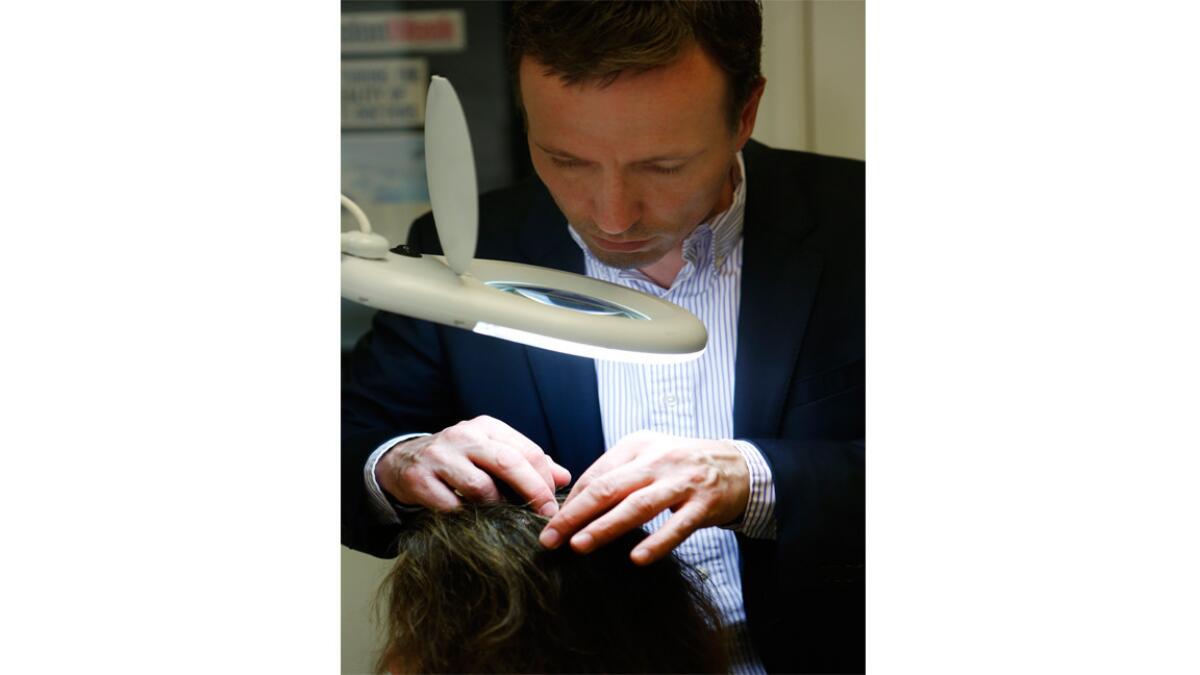Eight beauty mistakes women make that can lead to thinning hair or hair loss
- Share via
The most dreaded words for a woman to hear while she’s in her hairstylist’s chair?
“You have a bald spot.”
It’s something that a lot more women appear to be hearing. About one in four are experiencing premature hair loss, whether it’s thinning at the top of the scalp, a widening part or hairless patches, according to the American Hair Loss Assn.
“Awareness of, and willingness to act on, a hair loss problem has increased dramatically over the last 10 years,” said Lars Skjoth, founder and head of research and development for Harklinikken hair regrowth clinics, which recently opened a Beverly Hills location.
From what Skjoth has seen, 30% of women in their 30s are thinning noticeably. By the time they get to their 50s, half of all women will have some noticeable degree of hair loss.
“It’s not just about aging; 20% of my patients are millennials,” Skjoth says. “Hair loss has become a factor of the way we live.”
Bruce Katz, clinical professor of dermatology at New York’s Icahn School of Medicine at Mount Sinai agreed that “the problem has become more prevalent, and we’re not sure why.”
He often sees temporary hair loss in patients, caused by sudden stress, hormonal changes brought on by childbirth, or even crash dieting.
“They develop a general shedding, but the hair does grow back in many cases,” he said. More worrying is when the hair starts to fall out for no apparent reason, for which conventional remedies like Minoxidil or Rogaine are typically prescribed.
The emotional toll of balding in women can be crippling.
“It’s been socially acceptable for centuries for men to lose their hair,” said Shane Malek, a chemist and chief executive and founder of Scalp Med, which makes over-the-counter scalp treatment products. “Meanwhile, women have had to suffer privately. Even medical professionals tend to brush it under the rug as something women just have to deal with.”
Many patients have unwittingly brought the condition on themselves, Skjoth said. He and medical director Panos Vasiloudes oversee 22 clinics in Europe, the U.S. and Dubai.

Patients have their scalp examined with equipment that magnifies the follicles up to 200 times. (They can also consult via FaceTime or Skype.) They are asked about their diet, lifestyle, stress levels and emotional health, all factors that can contribute to hair thinning and loss.
Not everyone can be helped. If the condition is too far gone or the follicles are damaged, nothing is going to make hair grow back. Everyone else is given a regimen of specially concocted treatment products with plant extracts and a proprietary milk-derived formulation to use at home.
Here are eight healthy habits that Skjoth recommends to help you put an end to — or at least slow down — hair thinning and loss:
1. Reconsider those extensions
“How you style and groom your hair is a huge factor,” Skjoth said. He sees thousands of women with damage caused by hair extensions, causing traction alopecia -- hair loss brought on by continual pulling, leading to inflammation in the follicles. “Damage from braiding, weaving and hair extensions are very common.” Hair that is consistently pulled back — say in a tight ponytail -- can cause scarring in the hair follicles, resulting in permanent hair loss.
2. Put down the blow dryer
“Avoid daily blow-drying with high heat,” said Skjoth. “Be careful about the styling products you use. They easily come in contact with the scalp and can cause allergic reactions and follicle infections.”
3. Don’t wash your hair before bed
“People take a shower at night and they wrap wet hair in a ponytail and go to sleep.” The result: possible fungal infections. Dry hair completely before bed, and never sleep in a tight ponytail.
4. You’re washing your hair all wrong
Shampoo the scalp, rubbing in circular motions, and not the whole head of hair. Only apply conditioner from the ears down. Do both concurrently. Wash shampoo off first, then the conditioner. Skjoth says this process maintains the best scalp environment.
5. Dry shampoo is not your friend
With prolonged use, it can leave tiny powdered fibers and chemicals sitting on the surface of the scalp. The potential result: contact dermatitis, which can lead to shedding.
6. Rethink what you drink
According to Skjoth, the demineralization of drinking water can be a contributing factor to health problems, including hair loss. He recommends sticking to mineral-rich and pure spring waters like Evian, Vittel, Acqua Panna and Volvic.
7. Check your vitamins
Deficiencies in vitamin D, iron and ferritin can result in hair loss, Skjoth says. Talk to your doctor about what supplements may be right for you.
8. Your diet is … junk
People experiencing hair loss may not getting enough of certain nutrients. To rectify: Consume more essential fatty acids, minerals, proteins. “If you are living primarily on processed foods, the body has to find ways to compensate. The lack of certain nutrients affects the hormonal system and creates less than optimal conditions for growing good hair.”
The anti-hair-loss market has exploded with offerings. Here are three new ones to try:
NeuHair, a spray foam containing biotin, panthenol and silk amino acids, helps halt hair breakage, keeps the scalp nourished and thickens the hair you have. $150. skinresearchlabs.com
The FDA-approved NutraStim Laser Hair Comb is directed toward those who have androgenic alopecia -- a thinning crown, receding hairline or widening part. A dozen low-level lasers boost blood flow and circulation in the scalp. $279. nutrastimhair.com
Minoxidil boosts the two-step treatment protocol from Scalp Med, which also includes herbs like saw palmetto, the uva-ursi leaf, pygeum tree bark extract and zinc. $29.95 for a two-month supply. scalpmed.com
To read the article in Spanish, click here
READ ON!
Why midnight snacking is the worst
7 reasons why you can’t lose the weight
Actress Sofia Vergara’s secret? Lifting weights










